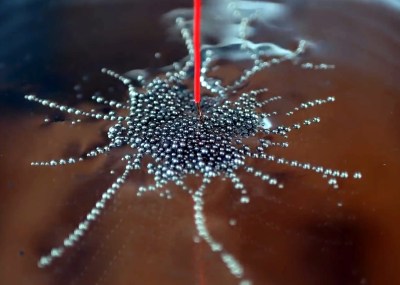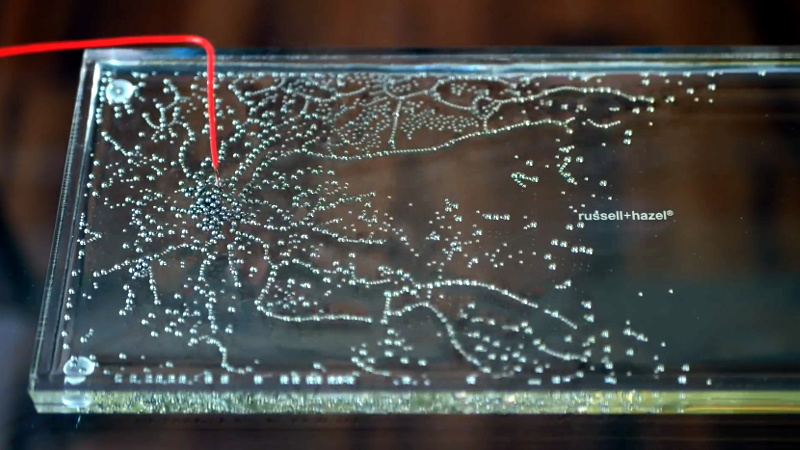Have you ever seen something that’s so fascinating you’re sure there has to be some kind of practical application for it, but you just can’t figure out what? That’s how we feel when watching tiny ball bearings assemble themselves into alien-like structures under the influence of high voltage in the latest Plasma Channel video from [Jay Bowles].
Now to be clear, [Jay] isn’t trying to take credit for the idea. He explains that researchers at Stanford University first documented the phenomenon back in 2015, and that his goal was to recreate their initial results as a baseline and go from there. The process is pretty simple: put small metal ball bearings into a tray of oil, apply high voltage, and watch them self-assemble into “wires” that branch out in search of the ground terminal like a plant’s roots looking for water. With the encouragement of his 500,000 volt Van de Graaff generator, the ball bearings leaped into action and created structures just like in the Stanford study.
 With the basic pieces now in place, [Jay] starts to push the envelope. He experiments with various oils to see how their viscosity impacts the ball’s ability to assemble, finding that olive oil seems to be the ideal candidate (at least of those he’s tried so far). He also switches up the size and shape of the tray, to try and find how far the balls can realistically stretch out on their own.
With the basic pieces now in place, [Jay] starts to push the envelope. He experiments with various oils to see how their viscosity impacts the ball’s ability to assemble, finding that olive oil seems to be the ideal candidate (at least of those he’s tried so far). He also switches up the size and shape of the tray, to try and find how far the balls can realistically stretch out on their own.
In the end we’re no closer to finding a practical application for this wild effect than the good folks at Stanford were back in 2015, but at least we got to watch the little fellows do their thing in glorious 4K and with the exceptional production value we’ve come to expect from Plasma Channel. That said, [Jay] does hint at his ongoing efforts to turn the structures into works of art by “freezing” them with clear resin, so keep your eyes out for that.
















Ah ha, radiating, reminds me of various claims high voltage & pulsed magnetic fields could offer gravity perturbations, with an altered directional vector oriented suitable high electric voltage field/magnetic shear could offer “torque against space” or something of that ilk – it might well be possible as so much Not explored it seems in public eye. It might explain the recent round of discussions re military being required by trump to release UFO info next next few weeks (only useful) thing I consider entertaining ;-)
Thanks for posting, intriguing especially since I have discovered an anomaly in electromagnetics on Galilean relativity, worth checking, so got some 1600Amp MOSFETs & few other very high current pulsed sources, will take a while though,
Will look into this when I get back, in meantime the might be relevant:-
https://www.quora.com/What-is-the-updated-status-of-the-military-bill-president-Trump-signed-late-2020-which-included-requirements-to-release-of-UFO-information-Did-President-Biden-cancel-that-clause-as-an-executive-action-if-so-why
Wow, I havent been on quora for some time and scrolling through the related articles really gives a reddit orange man bad vibe :(
Welcome to the crazydome!
The only people who are especially concerned about these “UFOs” are people who don’t understand math. I’d have expected the folks here on HaD to be a bit better at critical thinking.
Here’s a nice breakdown of some of the recent UFO drama:
https://www.youtube.com/watch?v=mfhAC2YiYHs
This one rehashes some of the same info, but also goes into some more depth on basic physics and infrared imaging, with a few source for more info:
https://www.youtube.com/watch?v=VCH7BWGpl5s
Caution: Thunderf00t is… annoying at times, but certainly knows his stuff. He can do trigonometry at least, which is more than can be said of Tucker Carlson.
Mick West does a better job with these videos, without the bombast.
https://www.youtube.com/watch?v=Le7Fqbsrrm8
Short story: pyramids are triangular irises, weather balloons moving at 200 mph are parallax, and saucer-shaped objects are flare from jet engines — rotation is caused by the observing camera’s gimbal.
In all of these, the pilot’s lack of situational awareness leads to them misperceiving the distance to the objects, which is why they think they’re moving so fast. This also explains a lot of the commercial pilots’ “drone” sightings where they’re moving at improbable speeds or at improbable altitudes. Human perception, especially in snap judgements like that, is fallible and persistent.
Please no more talk of UFOs. The world is crazy enough without adding crazy to crazy.
(PS. I’m totally fine with phenomena being difficult to explain, or even unexplained. But look for reasonable explanations first?)
Looks nice, but the article fails to point out what’s special about this – what is it?
it looks nice :)
That’s the whole point. It’s a cool phenomenon, and looks like some kind of alien tech, but there’s no obvious use for it. The criteria required to get these structures to self assemble is too strict, at least for now.
So like pretty much every other discovery in history, we study it and get more eyes/brains on it until something clicks.
He must of seen this floating around the youtube the other week
https://youtu.be/w1d0Lg6wuvc
Nice work and production. Thank you.
Try putting balls at both ends and let them reach for each other. This HV ball bearing testing seems to provide an easy way to reproduce how lightning works…. step leaders… and attracting upward streamers to meet the step leader… Search for high speed video of lightning.
Here is one lightning video that is quick and to the point: https://www.youtube.com/watch?v=RLWIBrweSU8
I remember how my jaw dropped when I watched that show.
It reminds me of dendrites in lithium-ion batteries, probably the same effect. Interesting that the lower viscosity prevented the dendrites frm forming. This may have some practical application, after all.
It reminds me of the PBS NOVA program on slime molds: https://www.pbs.org/wgbh/nova/video/slime-mold-smarts/
Anybody else notice the some of the beads bouncing from one strand to the other? It’s would repel from the higher charge strand, touch the lower charge strand, then get attracted back to the higher charge strand, then repeat?
That was very neat to watch.
ElectroBOOM gave it a try also. It seems pretty dependent on the oil viscosity.
https://youtu.be/FISUqoODw9Q?t=308
How about slightly shaking the tray to prevent the ball bearings to get stuck on the surface tension ?
Well I could say “If you put high voltage on my balls they would jump around too!” But, fortunately, I’m above that sort of thing. Still neat though.
He used olive oil on his balls but was it virgin ?
Isn’t this similar to the coherers that people used for signal amplification before vacuum tubes and crystal detectors? Those used iron filings that cohered into a conductive path when one terminal saw a voltage spike, and then had to be knocked out of conduction by a solenoid knocker afterwards, but the overall function seems pretty similar.